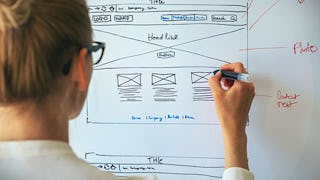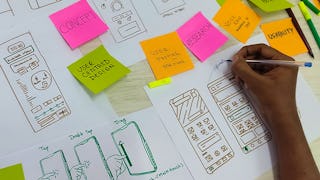With user experience now a top priority, the UX/UI design market is growing fast (Global Growth Insights). Talented UI/UX designers are in high demand! This course gives you the essential skills to confidently take your next step in learning UX/UIdesign.

Saving $160 on access to 10,000+ programs is a holiday treat. Save now.


Introduction to UX/UI Design
This course is part of IBM UI/UX Designer Professional Certificate


Instructors: IBM Skills Network Team
7,768 already enrolled
Included with 
(50 reviews)
Recommended experience
What you'll learn
Critical knowledge and skills in UX/UI essentials you need to launch your UX/UI journey
How to distinguish between User Experience (UX) and User Interface (UI) design and understand their impact on user satisfaction
Apply knowledge of UX/UI roles, job paths, Agile team dynamics, and their alignment with product goals in real-world workflows
Gain hands-on experience with tools such as Figma and learn to choose the right tools for different projects and teams
Skills you'll gain
Details to know

Add to your LinkedIn profile
11 assignments
See how employees at top companies are mastering in-demand skills

Build your Design and Product expertise
- Learn new concepts from industry experts
- Gain a foundational understanding of a subject or tool
- Develop job-relevant skills with hands-on projects
- Earn a shareable career certificate from IBM

There are 4 modules in this course
In this module, you’ll learn the foundational concepts of UX and UI design, highlighting their significance in creating impactful digital products. You will also learn to distinguish between UX and UI design, understand their unique roles, and explore how they complement each other in the design process. This module also covers the critical importance of UX/UI design in driving product success, enhancing user satisfaction, and achieving business goals. Additionally, you will examine real-world examples of exceptional UX/UI design, gaining insights into how thoughtful design can transform user experiences and create competitive advantages. By the end of this module, you will have a clear understanding of what UX and UI design entail, their differences, and their collective impact on modern product development.
What's included
15 videos4 readings3 assignments6 plugins
In this module, you will explore the significance of UX/UI design in various applications and its integration into the software development process. You will examine the role of UX/UI in websites, mobile apps, software, Internet of Things (IoT) devices, and emerging technologies such as AR/VR, voice interfaces, and wearable tech. Additionally, the module delves into the software development lifecycle (SDLC), illustrating how UX/UI design fits into its phases and contributes to iterative development and testing. By the end of this module, you will understand the critical role UX/UI design plays in ensuring usability, functionality, and innovation throughout product development.
What's included
9 videos2 readings3 assignments1 discussion prompt6 plugins
In this module, you’ll explore careers in UX/UI design, introducing you to various roles and the skills and tools essential for success in the field. You will learn about key professionals in product development, including designers, developers, project managers, and business analysts, and understand the collaborative nature of the design process. This module covers a range of career paths, such as UX Designer, UI Designer, Product Designer, and UX Researcher, with specializations such as Accessibility and Motion Design. Additionally, you will develop technical skills in wireframing, prototyping, user research, interaction design, and soft skills such as communication, problem-solving, and collaboration. You will gain hands-on experience with tools such as Figma, Adobe XD, Miro, and InVision, learning to choose the right tools for different projects and teams. The module also examines the dynamics of solo versus team-based work, highlighting how collaboration impacts the UX/UI process. By the end of the module, you will be prepared for a successful career in UX/UI design, equipped with the knowledge, skills, and tools required.
What's included
12 videos3 readings4 assignments1 discussion prompt9 plugins
In this module, you will complete a final project and will take a final exam to test your knowledge. The module also provides guidance about the next steps after completing this course.
What's included
2 videos2 readings1 assignment1 app item2 plugins
Earn a career certificate
Add this credential to your LinkedIn profile, resume, or CV. Share it on social media and in your performance review.
Offered by
Explore more from Design and Product
 Status: Free Trial
Status: Free Trial Status: Free Trial
Status: Free Trial Status: Free Trial
Status: Free Trial Status: Free Trial
Status: Free TrialIndian Institute of Technology Guwahati
Why people choose Coursera for their career




Learner reviews
50 reviews
- 5 stars
79.24%
- 4 stars
18.86%
- 3 stars
1.88%
- 2 stars
0%
- 1 star
0%
Showing 3 of 50
Reviewed on Nov 13, 2025
Awesome Experience, loved the way the learning methodology is used.
Reviewed on Oct 11, 2025
I love the speed of the course yet very insightful

Open new doors with Coursera Plus
Unlimited access to 10,000+ world-class courses, hands-on projects, and job-ready certificate programs - all included in your subscription
Advance your career with an online degree
Earn a degree from world-class universities - 100% online
Join over 3,400 global companies that choose Coursera for Business
Upskill your employees to excel in the digital economy
Frequently asked questions
UX (User Experience) focuses on creating smooth, intuitive experiences for users, making sure the product is easy and enjoyable to use. UI (User Interface) deals with the visual aspects—like colors, buttons, and layout—making the product aesthetically appealing. Both work together to ensure the product is usable and delightful.
Not necessarily! While some designers learn basic HTML or CSS, many focus primarily on design and user experience. The key skills involve understanding user behavior and design principles, as well as proficiency with design tools like Figma and Sketch.
UX/UI designers collaborate with product managers, developers, and stakeholders to ensure user needs are reflected throughout the product lifecycle. They contribute at every stage—from initial research and ideation to prototyping and usability testing—helping align design outcomes with project goals.
More questions
Financial aid available,

